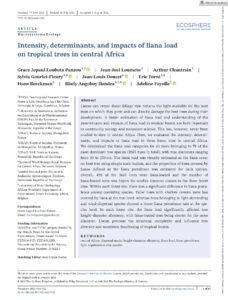
Lianas can create dense foliage that reduces the light available for the host trees on which they grow and can directly damage the host trees during their development. A better estimation of liana load and understanding of the determinants and impacts of liana load in tropical forests are both important in community ecology and ecosystem science. This has, however, never been studied to date in central Africa. Here, we evaluated the intensity, determinants, and impacts of liana load in three forest sites in central Africa. We determined the liana load categories for all trees belonging to 78 of the most dominant tree species (2683 trees in total), with tree diameters ranging from 10 to 250 cm. The liana load was visually estimated as the liana cover on host tree using simple scale indices, and the proportion of trees covered by lianas defined as the liana prevalence was estimated for each species. Overall, 42% of the 2683 trees were liana-loaded and the number of liana loaded trees was higher for smaller diameter classes in the three forest sites. Within each forest site, there was a significant difference in liana prevalence among coexisting species. Taller trees with shallow crowns were less covered by liana at the tree level, whereas trees belonging to light-demanding and wind-dispersed species showed a lower liana prevalence rate at the species level. In each forest site, the liana load significantly affected tree height–diameter allometry, with liana-loaded trees being shorter for the same diameter. Lianas promote the structural complexity and influence tree diversity and ecosystem functioning of tropical forests.
Consultez la notice complète de l’article sur ORBi
